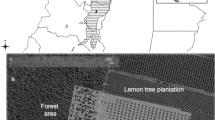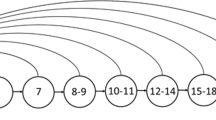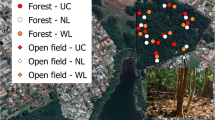Abstract
Miconia calvescens (Melastomataceae) is a serious invader in the tropical Pacific, including the Hawaiian and Tahitian Islands, and currently poses a major threat to native biodiversity in the Wet Tropics of Australia. The species is fleshy-fruited, small-seeded and shade tolerant, and thus has the potential to be dispersed widely and recruit in relatively intact rainforest habitats, displacing native species. Understanding and predicting the rate of spread is critical for the design and implementation of effective management actions. We used an individual-based model incorporating a dispersal function derived from dispersal curves for similar berry-fruited native species, and life-history parameters of fecundity and mortality to predict the spatial structure of a Miconia population after a 30 year time period. We compared the modelled population spatial structure to that of an actual infestation in the rainforests of north Queensland. Our goal was to assess how well the model predicts actual dispersion and to identify potential barriers and conduits to seed movement and seedling establishment. The model overpredicts overall population size and the spatial extent of the actual infestation, predicting individuals to occur at a maximum 1,750 m from the source compared with the maximum distance of any detected individual in the actual infestation of 1,191 m. We identify several characteristic features of managed invasive populations that make comparisons between modelled outcomes and actual infestations difficult. Our results suggest that the model’s ability to predict both spatial structure and spread of the population will be improved by incorporating a spatially explicit element, with dispersal and recruitment probabilities that reflect the relative suitability of different parts of the landscape for these processes.





Similar content being viewed by others
References
Buckley YM, Anderson S, Catterall CP et al (2006) Management of plant invasions mediated by frugivore interactions. J Appl Ecol 43:848–857
Chimera CG, Medeiros AC, Loope LL et al (2000) Status of management and control efforts for the invasive alien tree Miconia calvescens DC. (Melastomataceae) in Hana, East Maui. Hawai’i, 53 pp
Clark CJ, Poulsen JR, Parker VT (2001) The role of arboreal seed dispersal groups on the seed rain of a lowland tropical forest. Biotropica 33:606–620
Csurhes SM (1998) Miconia calvescens, a potentially invasive plant in Australia’s tropical and sub-tropical rainforests. In: Meyer JY, Smith CW (eds) Proceedings of the First Regional Conference on M. calvescens Control. Papeete, Tahiti, French Polynesia. Gouvernement de Polynésie française/University of Hawai’i at Manoa/Centre ORSTOM de Tahiti, 90 pages + appendix
Dennis AJ, Westcott DA (2007) Estimating dispersal kernels produced by a diverse community of vertebrates. In: Dennis AJ, Schupp EW, Green RJ, Westcott DA (eds) Seed dispersal: theory and its application in a changing world. CAB International, Wallingford, UK
Edwards RH (1996) Pest Status Review—M. calvescens (Melastomataceae). Report presented to the Queensland Rural Lands Protection Board Meeting 16–17 July 1996. Queensland Department of Natural Resources. Brisbane (unpublished report)
Ellison AM, Denslow JS, Loiselle BA et al (1993) Seed and seedling ecology of neotropical melastomaceae. Ecology 74:1733–1749
Ferguson RN, Drake DR (1999) Influence of vegetation structure on spatial patterns of seed deposition by birds. NZ J Bot 37:361–677
Fine PVA (2002) The invasibility of tropical forests by exotic plants. J Trop Ecol 18:687–705
Kaiser BA (2006) Economic impacts of non-indigenous species: Miconia and the Hawaiian economy. Euphytica 148:135–150
Kennedy TA, Naeem S, Howe KM et al (2002) Biodiversity as a barrier to ecological invasion. Nature 417:636–638
Levey DJ, Silva WR, Galetti M (2002) Seed dispersal and frugivory: ecology, evolution and conservation. CABI, United Kingdom
Levine JM, Adler PB, Yelenik SG (2004) A meta-analysis of biotic resistance to exotic plant invasions. Ecol Lett 7:975–989
Lockwood JL, Cassey P, Blackburn T (2005) The role of propagule pressure in explaining species invasions. TREE 20:223–228
Medeiros AC, Loope LL, Conant P et al (1997) Status, ecology, and management of the invasive plant, Miconia calvescens DC (Melastomataceae) in the Hawaiian Islands. Bishop Mus Occas Pap 48:23–36
Metcalfe DJ, Grubb PJ (1995) Seed mass and light requirements for regeneration in southeast-Asian rain forest. Can J Bot 6:817–826
Metcalfe DJ, Grubb PJ, Turner IM (1998) The ecology of very small-seeded shade-tolerant trees and shrubs in lowland rain forest in Singapore. Plant Ecol 134:131–149
Meyer J-Y (1996) Status of Miconia calvescens (Melastomataceae), a dominant invasive tree in the Society Islands (French Polynesia). Pac Sci 50:66–76
Meyer J-Y (1998a) Observations on the reproductive biology of Miconia calvescens DC (Melastomataceae), an alien invasive tree on the island of Tahiti (South Pacific Ocean). Biotropica 30:609–624
Meyer J-Y (1998b) Epidemiology of the invasion by Miconia calvescens and reasons for a spectacular success. In: Meyer JY, Smith CW (eds) Proceedings of the first regional conference on M. calvescens control. Papeete, Tahiti, French Polynesia. Gouvernement de Polynésie française/University of Hawai’i at Manoa/Centre ORSTOM de Tahiti, 90 pages + appendix
Meyer J-Y, Florence J (1996) Tahiti’s native flora endangered by the invasion of Miconia calvescens DC. (Melastomataceae). J Biogeogr 23:775–783
Meyer J-Y, Malet JP (1997) Study and management of the alien invasive tree Miconia calvescens DC. (Melastomataceae) in the islands of Raiatea and Tahaa (Society Islands, French Polynesia): 1992–1996. Manoa, University of Hawai’i, Manoa, 56 pp
Muller-Landau HC, Hardesty BD (2005) Seed dispersal of woody plants in tropical forests: concepts, examples, and future directions. In: Burslem D, Pinard MA, Hartley S (eds) Biotic interactions in the tropics. Cambridge University Press, Cambridge, pp 267–309
Puth LM, Post DM (2005) Studying invasion: have we missed the boat. Ecol Lett 8:715–721
Schupp EW (1993) Quantity, quality and effectiveness of seed dispersal by animals. Vegetatio 107/108:15–29
Schupp EW, Milleron T, Russo SE (2002) Dissemination limitation and the origin and maintenance of species-rich tropical forests. In: Levey DJ, Silva WR, Galetti M (eds) Seed dispersal and frugivory: ecology, evolution and conservation. CABI, UK, pp 19–33
Tobin PC, Whitmire SL, Johnson DM et al (2007) Invasion speed is affected by geographical variation in the strength of Allee effects. Ecol Lett 10: 36–43
Wenny DG, Levey DJ (1998) Directed seed dispersal by bellbirds in a tropical cloud forest. Proc Nat Acad Sci USA 95:6204–6207
Westcott DA, Dennis AJ (2006) Incorporating dispersal ecology into the management of plant invasions. In: Preston C, Watts JH, Crossman ND (eds) Proceedings of the 15th Australian weeds conference, Weed Management Society of South Australia
Westcott DA, Bradford MG, Dennis AJ et al (2005a) Keystone fruit resources and Australia’s tropical rain forests. In: Dew JL, Boubli JP (eds) Tropical fruits and frugivores: the search for strong interactors. Springer, Netherlands, pp 237–260
Westcott DA, Bentrupperbäumer J, Bradford MG et al (2005b) Incorporating patterns of disperser behaviour into models of seed dispersal and its effects on estimated dispersal curves. Oecologia 146:57–67
Westcott DA, Setter M, Bradford MG et al (2007) Cassowary dispersal of the invasive pond apple in a tropical forest: the contribution of subordinate dispersal modes in invasion. Diversity Distrib doi:10.1111/j.1472-4642.2007.00416.x
Wet Tropics Management Authority (WTMA) (2005) 1:50,000 vector drainage hydrology streams network. Wet Tropics Management Authority, Cairns
Wet Tropics Management Authority (WTMA) (2006) Stanton and Stanton vegetation mapping. Wet Tropics Management Authority, Cairns
Wheelwright NT, Orians GH (1982) Seed Dispersal by animals: contrasts with pollen dispersal, problems of terminology, and constraints on coevolution. Am Nat 119:402–413
With KA (2002) The landscape ecology of invasive spread. Conserv Biol 16:1192–1203
With KA (2004) Assessing the risk of invasive spread in fragmented landscape. Risk Anal 24:803–815
Acknowledgements
This project was funded by CSIRO, the CRC for Australian Weed Management and the Australian Government’s Marine and Tropical Sciences Research Facility, and supported by the Biosecurity Queensland ‘Four Tropical Weeds’ group. John Ludwig, Graham Harrington and Travis Sydes reviewed the paper and provided valuable comments.
Author information
Authors and Affiliations
Corresponding author
Rights and permissions
About this article
Cite this article
Murphy, H.T., Hardesty, B.D., Fletcher, C.S. et al. Predicting dispersal and recruitment of Miconia calvescens (Melastomataceae) in Australian tropical rainforests. Biol Invasions 10, 925–936 (2008). https://doi.org/10.1007/s10530-008-9246-x
Received:
Published:
Issue Date:
DOI: https://doi.org/10.1007/s10530-008-9246-x






